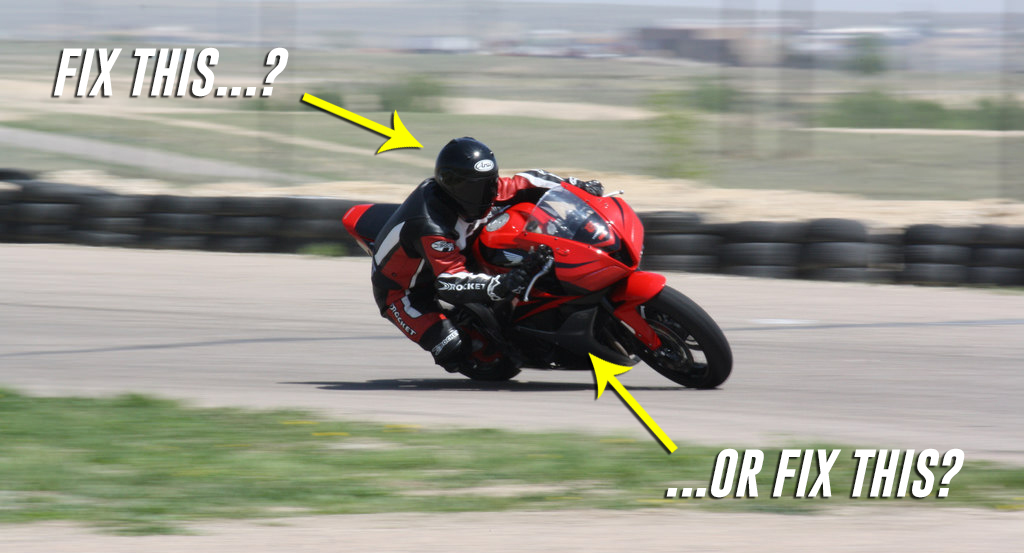Bike Issue or Rider Issue? Get Greater Results by Focusing on the Right Tool

There are numerous things that go into making a rider fast. One huge part is, quite obviously, a well maintained and setup machine that’s capable of doing the job you’re asking it to do.
However, if we’re honest with ourselves, and given the extraordinary level that performance machines sit at right off the shelf, you have to reach a pretty high level as a rider before you can truly begin to blame a machine for holding you back.
Most riders will know that the potential of their bike will sit higher than they’re currently able to extract, particularly at track day level, but it doesn’t stop a vast array of riders itching to get their wallets (or purses) out for the next bolt-on upgrade, or for a new bike entirely.
Now, I’ve spoken in the past about when the right time is to upgrade so we won’t touch on that here. The only point I want to make here is to challenge you to spend more time looking at yourself as a rider as opposed to spending your hundreds (or thousands) on bike upgrades in the hope it’ll net a positive lap time return.
It’s Probably Not the Bike’s Fault
I remember seeing a discussion on a forum not too long ago around the difference between two top end 1000cc sports bike.
The rider that made the post owned a one of the models, but claimed it was very frustrating to ride because it had no punch out the corners and he was losing out to other high end machines at the tracks he rode.
My first thought was, yeah, your particular machine is known to be is relatively gutless from low down compared to other bikes, but I still wasn’t convinced.
Upon looking at the chap’s footage he’d posted I could see that he was charging into corners, often apexing too early (when he actually hit an apex), as well as being a little over eager to start his drive out the corners too, further spoiling his exit.
Now, I’m not here to judge the guy’s riding, we can all improve, but I did chuckle to myself as I read his post and saw his adamance that a different bike would be the answer, when there was clearly a number of ways in which he could improve his corner exit drive without spending a penny.
This Happens with Bike Setup Too
Another place I often see this “bike before rider” feeling is not with upgrades, but with setup.
Sometimes I’ll hear a rider say “my bike doesn’t steer”, but after more questioning we discover it’s only in a couple of corners, both of which go left, for instance.
Or they’ll say something like “my bike always runs wide in this corner”, only to later see that they’re simply not being patient enough with the throttle in the middle of that corner.
Whenever a bike sporadically has an issue and doesn’t do what you’d like, this most often points to an issue with the rider, not one coming from the motorcycle itself.
Look at Yourself… Or Get Help
I’ve had many face-palm moments when listening to riders talk about how much they’re struggling with their riding, for me or something else to then casually suggest getting some help to ride faster (and safer), only to be met with general disinterest or even a flat out “I can’t afford it”…
… then later on you discover they have a brand new Suzuki GSX-R1000 sitting in the next garage from you.
Maybe it stems from watching racers on TV where they’re always talking about how their bike can be improved (because there’s always going to be weak spots) that has riders turning to the machine first, I don’t know, but I do know that a healthy majority could reach much higher levels on a lot less money by focusing their time and resources on the squidgy thing sitting on top of the motorcycle.
That could be just learning whatever you can from a trusted source and working things out yourself, going to a riding school, or getting some high-end coaching from a skilled coach.
Whatever it is, whenever you feel there’s an issue with the bike and it’s not doing what you’d like it to do, I’d encourage your first internal question to be…
“How can I make this better?”
Because at track day level the answer to an on-track problem will most often lie in what the rider is doing to hold themselves back, not in a deficiency in the bike itself.
It’s an approach that requires you to lose the ego as well as to stop looking for shortcuts, but an approach that is going to bring you greater gains long term, and possibly have you staying out the kitter litter more often too.
Photo by Michael Dunn
Related Posts
Body Position: What the Bike Wants From You As a Rider
How to Get the Most from Your Track Time: Pre-Ride Prep & How to Approach Your Day
How to Deal With the Panic When Someone Takes Your Line
Learning to Trust Your Tyres Through Technique & Experience
